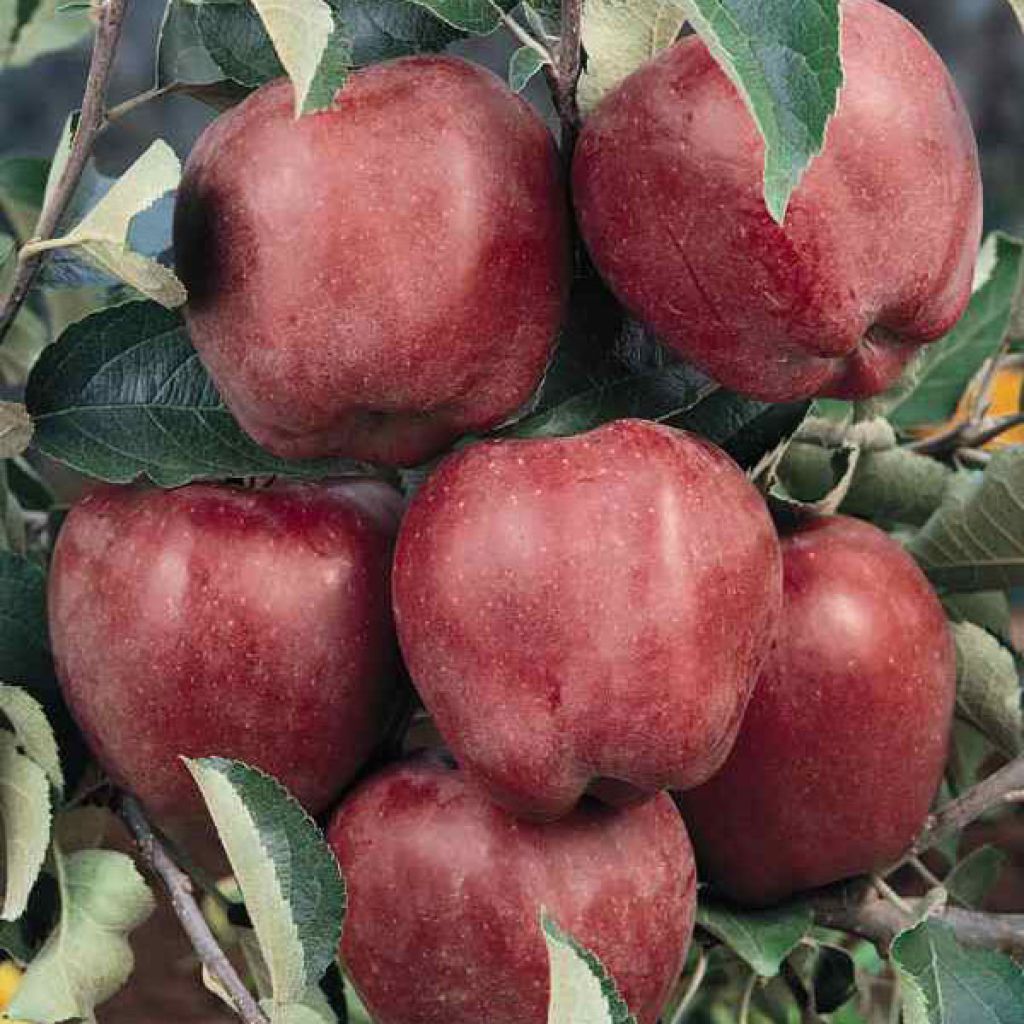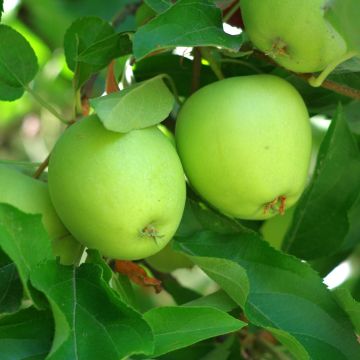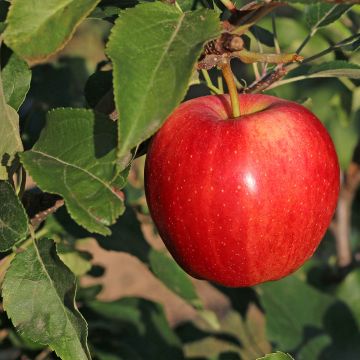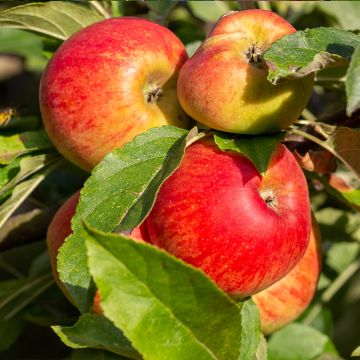

Apple Tree Starking Delicious - Malus domestica
Apple Tree Starking Delicious - Malus domestica
Malus domestica Starking Delicious
Apple, Orchard apple, Table apple, Cultivated apple
n'ai pas reçu cet article
senol, 05/11/2023
This item cannot be shipped to the selected country
Oversize package delivery charge from €6.90
More information
Schedule delivery date,
and select date in basket
This plant carries a 6 months recovery warranty
More information
We guarantee the quality of our plants for a full growing cycle, and will replace at our expense any plant that fails to recover under normal climatic and planting conditions.
Oversize package: home delivery by special carrier from €6.90 per order..
Express home delivery from €8.90.
Description
The 'Starking Delicious' Apple is a vigorous variety that is productive and quick to bear fruit. It produces medium-sized fruits that are elongated, red-violet to dark garnet in colour, with white lenticels. Their white flesh is firm, melting, juicy, sweet, and has the characteristic aroma of Starking. Harvest takes place from late September to October. The fruits can be stored in a cool place until April. The 'Starking Delicious' Apple is not self-fertile.
The apple tree is a native tree of Europe, including France, where its presence has been documented since ancient times. The 'Starking Delicious' Apple is a natural mutation of Red Delicious, apparently stabilized by Stark Brothers nurseries in the USA in 1920.
The 'Starking Delicious' Apple is an upright tree, giving it a very elegant and slender appearance. Its production is regular and uniform. In case of excessive fruiting, thinning is necessary to avoid small fruit size and the occurrence of diseases.
Its foliage is composed of very large, ovate, slightly fuzzy leaves that are dark green on top and whitish-green underneath, with deeply toothed edges.
The white flowering occurs late, in late April. The flowering is therefore not afraid of strong frosts. The apple tree is therefore suitable for cultivation in all regions. Self-sterile, the presence of apple trees that flower at the same time is necessary. The varieties 'Reine des reinettes' and 'Golden Delicious' are the most suitable.
Fruiting begins in late September and extends into October. The fruits can be stored in a cool place (cellar or refrigerator) until April. They are medium-sized fruits that are elongated, red-violet to dark garnet in colour, with white lenticels. Their white flesh is firm, melting, juicy, and sweet, with the characteristic aroma of Starking.
These apples are particularly good for eating fresh. They can also be used in pastries, jams, jellies, or in savory dishes, paired with Normandy cheeses, for example.
Report an error about the product description
Apple Tree Starking Delicious - Malus domestica in pictures


Plant habit
Fruit
Flowering
Foliage
Botanical data
Malus
domestica
Starking Delicious
Rosaceae
Apple, Orchard apple, Table apple, Cultivated apple
Cultivar or hybrid
Other Apple trees
Planting and care
Choose a sunny spot for your 'Starking Delicious' Apple tree, the soil can be slightly chalky or acidic but without excess. Dig a wide planting hole at least 3 times the volume of the root ball. Simultaneously add organic matter (potting soil, compost) and a base fertilizer such as crushed horn. Do not bury the graft collar. Stake if necessary. Water abundantly, even in winter, even if it rains. Fruit trees are ideally planted between October and March, outside of freezing periods. Container-grown plants can be planted all year round, except during periods of high heat or frost.
In winter, you can add a small handful of wood ash, rich in potash, which will improve fruiting. Watch out for possible aphid attacks during the season. A white powdery coating due to a fungus, powdery mildew, may appear on the leaves in summer, but it does not harm fruit development in gardens. Harvest takes place in September. Only keep picked fruits for storage. Apples should be stored with the stem facing downwards, on shelves or in crates. Choose a preferably completely dark, dry and cool place, but frost-free.
Planting period
Intended location
Care
-
, onOrder confirmed
Reply from on Promesse de fleurs
Haven't found what you were looking for?
Hardiness is the lowest winter temperature a plant can endure without suffering serious damage or even dying. However, hardiness is affected by location (a sheltered area, such as a patio), protection (winter cover) and soil type (hardiness is improved by well-drained soil).

Photo Sharing Terms & Conditions
In order to encourage gardeners to interact and share their experiences, Promesse de fleurs offers various media enabling content to be uploaded onto its Site - in particular via the ‘Photo sharing’ module.
The User agrees to refrain from:
- Posting any content that is illegal, prejudicial, insulting, racist, inciteful to hatred, revisionist, contrary to public decency, that infringes on privacy or on the privacy rights of third parties, in particular the publicity rights of persons and goods, intellectual property rights, or the right to privacy.
- Submitting content on behalf of a third party;
- Impersonate the identity of a third party and/or publish any personal information about a third party;
In general, the User undertakes to refrain from any unethical behaviour.
All Content (in particular text, comments, files, images, photos, videos, creative works, etc.), which may be subject to property or intellectual property rights, image or other private rights, shall remain the property of the User, subject to the limited rights granted by the terms of the licence granted by Promesse de fleurs as stated below. Users are at liberty to publish or not to publish such Content on the Site, notably via the ‘Photo Sharing’ facility, and accept that this Content shall be made public and freely accessible, notably on the Internet.
Users further acknowledge, undertake to have ,and guarantee that they hold all necessary rights and permissions to publish such material on the Site, in particular with regard to the legislation in force pertaining to any privacy, property, intellectual property, image, or contractual rights, or rights of any other nature. By publishing such Content on the Site, Users acknowledge accepting full liability as publishers of the Content within the meaning of the law, and grant Promesse de fleurs, free of charge, an inclusive, worldwide licence for the said Content for the entire duration of its publication, including all reproduction, representation, up/downloading, displaying, performing, transmission, and storage rights.
Users also grant permission for their name to be linked to the Content and accept that this link may not always be made available.
By engaging in posting material, Users consent to their Content becoming automatically accessible on the Internet, in particular on other sites and/or blogs and/or web pages of the Promesse de fleurs site, including in particular social pages and the Promesse de fleurs catalogue.
Users may secure the removal of entrusted content free of charge by issuing a simple request via our contact form.
The flowering period indicated on our website applies to countries and regions located in USDA zone 8 (France, the United Kingdom, Ireland, the Netherlands, etc.)
It will vary according to where you live:
- In zones 9 to 10 (Italy, Spain, Greece, etc.), flowering will occur about 2 to 4 weeks earlier.
- In zones 6 to 7 (Germany, Poland, Slovenia, and lower mountainous regions), flowering will be delayed by 2 to 3 weeks.
- In zone 5 (Central Europe, Scandinavia), blooming will be delayed by 3 to 5 weeks.
In temperate climates, pruning of spring-flowering shrubs (forsythia, spireas, etc.) should be done just after flowering.
Pruning of summer-flowering shrubs (Indian Lilac, Perovskia, etc.) can be done in winter or spring.
In cold regions as well as with frost-sensitive plants, avoid pruning too early when severe frosts may still occur.
The planting period indicated on our website applies to countries and regions located in USDA zone 8 (France, United Kingdom, Ireland, Netherlands).
It will vary according to where you live:
- In Mediterranean zones (Marseille, Madrid, Milan, etc.), autumn and winter are the best planting periods.
- In continental zones (Strasbourg, Munich, Vienna, etc.), delay planting by 2 to 3 weeks in spring and bring it forward by 2 to 4 weeks in autumn.
- In mountainous regions (the Alps, Pyrenees, Carpathians, etc.), it is best to plant in late spring (May-June) or late summer (August-September).
The harvesting period indicated on our website applies to countries and regions in USDA zone 8 (France, England, Ireland, the Netherlands).
In colder areas (Scandinavia, Poland, Austria...) fruit and vegetable harvests are likely to be delayed by 3-4 weeks.
In warmer areas (Italy, Spain, Greece, etc.), harvesting will probably take place earlier, depending on weather conditions.
The sowing periods indicated on our website apply to countries and regions within USDA Zone 8 (France, UK, Ireland, Netherlands).
In colder areas (Scandinavia, Poland, Austria...), delay any outdoor sowing by 3-4 weeks, or sow under glass.
In warmer climes (Italy, Spain, Greece, etc.), bring outdoor sowing forward by a few weeks.










































